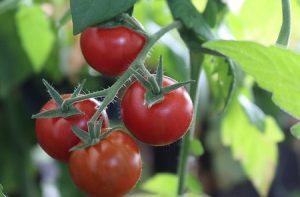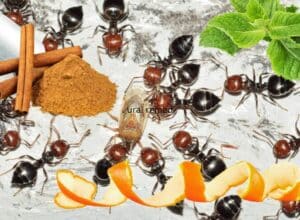Last Updated on October 2, 2023
Don’t know what to do with fresh grass clippings after mowing your lawn?
You can use them as mulch in your vegetable garden, around your trees, or in your flower beds!
Don’t have a garden? In that case, you can “grasscycle” by simply leaving the grass clippings on your lawn.
Let’s explore the benefits of mulching with grass clippings and learn how to use them as mulch, step-by-step.
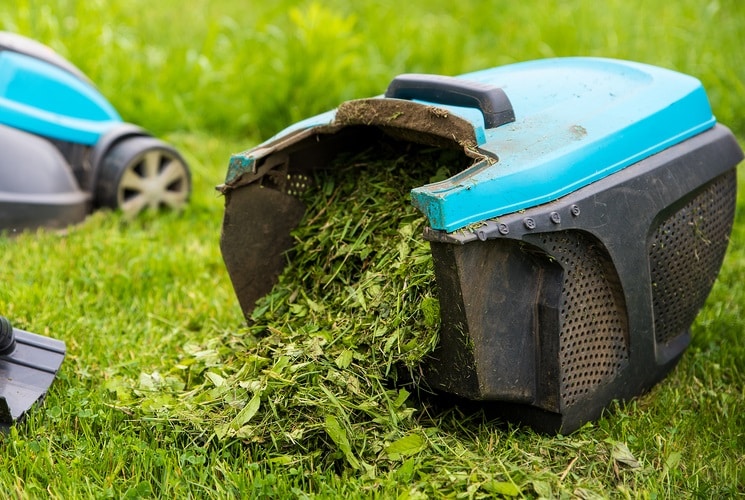
*This post contains affiliate links. If you choose to purchase any of the products I have recommended, I may receive a commission at no cost to you.
The Benefits of Using Grass Clippings as Mulch
Using grass clippings as mulch can offer several benefits:
1) Enhance moisture retention
Mulching with grass clippings helps to conserve moisture in the soil, reducing the frequency of watering.
2) Deter insects
Grass clippings can act as a natural deterrent to certain insects, helping to protect your plants from potential pests such as slugs, snails, and some crawling insects. The layer of grass clippings can create a barrier that makes it more difficult for these pests to reach and damage your plants.
3) Suppress weeds
A layer of grass clippings mulch can help prevent weed growth by blocking sunlight and reducing weed seed germination.
4) Promote healthy plant growth
Grass clippings, when used as mulch, provide organic matter and nutrients to the soil, supporting the growth and overall health of plants.
5) Enhance soil fertility
Grass clippings break down over time, enriching the soil with organic matter, which improves soil structure and fertility.
6) Reduce chemical use
Grass clippings obtained from chemical-free lawns eliminate the risk of introducing harmful chemicals or residues into the garden. It promotes a more organic and chemical-free gardening approach.
7) Reduce waste
Instead of sending grass clippings to landfills utilizing them as mulch reduces the volume of waste generated. By using them as mulch, you are repurposing and recycling organic material that would otherwise be discarded or require additional disposal efforts.
8) Save money
If you have grass in your yard, using the clippings as mulch is a convenient and free resource readily available to you. By using your own grass clippings from mowing your lawn you can save money by not needing to buy other types of mulch or weed fabric for your garden.
9) Save time
Mulching with grass clippings can reduce the time spent on watering and weeding, as the mulch helps retain moisture and suppress weed growth.
By using grass clippings as mulch, you can enjoy these benefits while promoting a healthier and more sustainable garden.
How to Use Grass Clippings for Mulching in Your Vegetable Garden
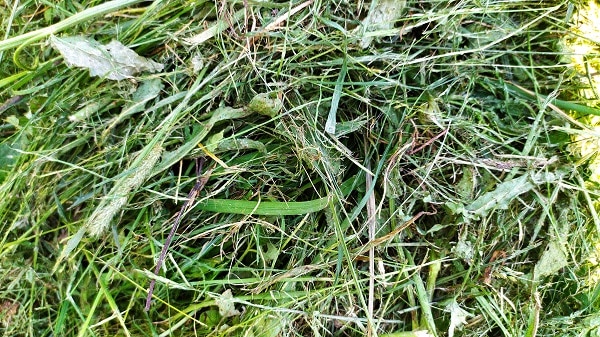
After you’re done mowing the grass with a lawn mower, weed eater, scythe, or sickle, don’t just throw away those fresh grass clippings! You can actually put them to good use in your vegetable garden, around your trees, or in your flower beds.
Important! Before using grass clippings from your lawn, make sure you haven’t applied any weed control or other chemical treatments. Residue from such treatments can harm your plants and lead to issues like curled leaves in plants.
The process of using grass clippings as mulch in simple, just follow these simple steps.
1) Choose the right day
Pick a sunny day that is warm to ensure the grass clippings dry out properly. You want them to turn brown and become a nice layer of mulch.
2) Fluff up the grass clippings
Avoid piling up thick layers of grass clippings, as this can lead to composting and heat buildup, which can harm your plants. Instead, spread the clippings out and fluff them up so that air can circulate and the sun can dry them effectively.
Alternatively to ensure the grass clippings are loose and dry, hold them up high and shake them down. Loose clippings will dry more effectively and create an ideal mulch layer for your plants.
3) Apply a thin layer
When applying the grass clippings as mulch, aim for a thickness of no more than half an inch. This thin layer will be sufficient to provide the benefits of mulching without causing any damage to your plants.
4) Allow drying and add another layer
Let the first layer of grass clippings dry out until they turn brown. Once they have dried, you can add another half-inch layer of clippings on top. This will create a nice, moisture-retaining mulch layer for your plants.
You can continue adding more grass clippings as mulch throughout the growing season,
5) Gently work the mulch around plants
When applying the grass clippings around your plants, ensure they are loose and allow air circulation. Gently work the mulch around the base of the plants, taking care not to create large mounds of clippings. Excessive heat generated from thick mulch can harm your plants.
6) Mulch the entire bed
Consider mulching the entire garden bed with grass clippings. This approach ensures consistent moisture retention and helps protect your plants from drying out due to the sun’s heat.
How to Use Grass Clippings as Mulch in Flower Beds
Wonder if you can use grass clippings in flower beds as mulch?
You deninately can!
Just follow proper mulching practices:
1) Thin layer
Apply a thin layer of grass clippings around your flowers, avoiding piling them too thickly. A layer of half an inch to an inch is generally sufficient.
2) Fluff and aerate
Before applying the grass clippings, fluff them up to ensure air can circulate through the layer of mulch. This helps prevent excess moisture and heat buildup.
3) Keep away from plant stems
Avoid placing the grass clippings directly against the stems of your flowers. Leave a small gap around the base of the plants to prevent any potential moisture-related issues or the risk of rot.
4) Allow clippings to dry and brown before applying another layer
Allow the grass clippings to dry out and turn brown before applying another layer of fresh grass clippings as mulch. This helps prevent the clippings from matting and creating a barrier that could block water and air from reaching the soil.
By following these guidelines, you can effectively use grass clippings as mulch in your flower beds, so it can benefit your plants and keep them healthy.
Is it OK to leave grass clippings on the lawn?
Yes, it is generally okay to leave grass clippings on the lawn. In fact, leaving grass clippings on the lawn can be beneficial for the health of your lawn and the environment. This practice is known as “grasscycling.”
Grass clippings are rich in nutrients like nitrogen, phosphorus, and potassium, which are essential for the growth of healthy grass. When you leave the clippings on the lawn, they decompose quickly and release these nutrients back into the soil, providing a natural fertilizer for your lawn.
Also, grass clippings act as a natural mulch, they help to retain moisture in the soil, regulate soil temperature, and reduce weed growth.
Tips on mulching lawn with grass clippings
To ensure that leaving grass clippings on your lawn is beneficial, it’s important to follow some best practices:
1) Mow regularly
Avoid cutting off more than one-third of the grass height in a single mowing session. If the grass is too long, it may clump and smother the underlying grass.
2) Use a mulching lawn mower
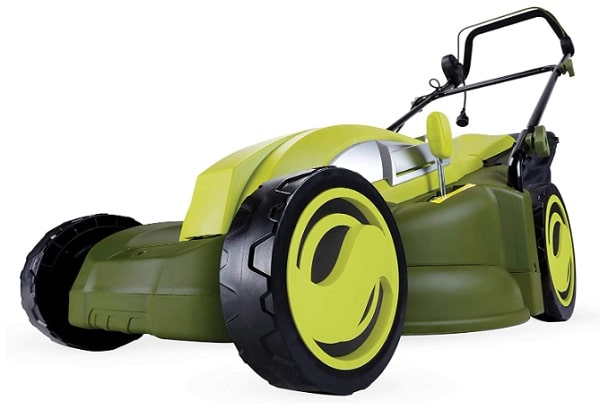
Mulching mowers are designed to cut grass into smaller pieces, making it easier for the clippings to decompose quickly.
3) Dry conditions
If the grass is wet, it may clump together, and it’s better to collect and remove the clippings to prevent them from suffocating the grass beneath.
By following these guidelines, leaving lawn clippings on the lawn can be a sustainable and beneficial practice for maintaining a healthy and beautiful lawn.
Can you use grass clipping from your lawn if it was mowed by a gas powered lawn mower?
Yes, you can still use grass clippings from a lawn mowed by a gas-powered lawn mower for mulching.
However, it’s important to ensure that no chemicals or treatments have been applied to the lawn before using the clippings. Be cautious if you have recently used herbicides or other chemical products on your lawn, as the residue from these treatments can potentially harm your plants when used as mulch.
If you haven’t used any such chemicals, the grass clippings can still provide beneficial mulch for your garden beds.
Read related:
Guide to gardening for beginners: 20 key steps
How to make soil fertile naturally
Best battery powered weed eaters
11 best Japanese gardening tools
Best backpack leaf blower for clearing fall leaves
Final Thoughts on Mulching with Grass Clippings
Using grass clippings as mulch is a smart and easy way to nourish your plants and keep them healthy.
Simply spread a thin layer of the clippings around your plants, making sure not to pile it up too thick. The clippings will help suppress weeds, retain moisture in the soil, and even save you some time and money. It’s a win-win situation for your garden!
And if you don’t have a garden, don’t worry. Just mow your grass in dry weather (ideally with a mulching lawn mower) and leave the grass clippings on the lawn
Mulching with grass clippings also helps the environment. When you recycle organic material like grass clippings, you reduce waste and conserve resources.
To make sure your plants stay healthy, it’s important to only use grass clippings that haven’t been treated with chemicals. By following the instructions in this article, you can easily use grass clippings as mulch in your garden beds. It’s a simple and eco-friendly way to take care of your plants and contribute to sustainability.
You have read:


